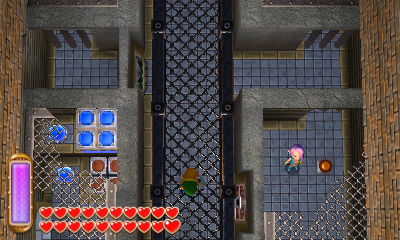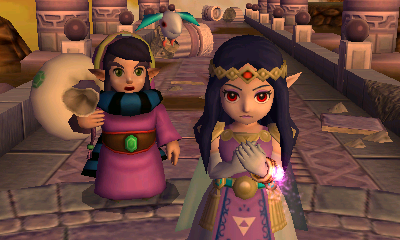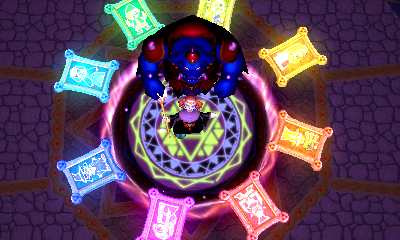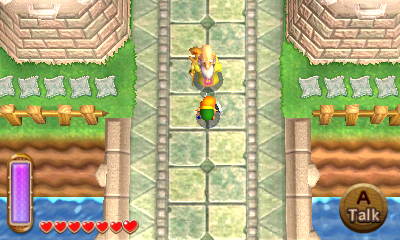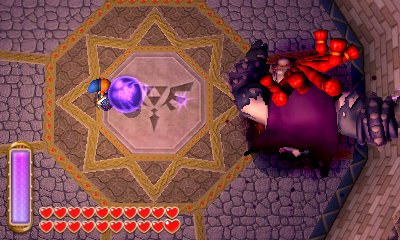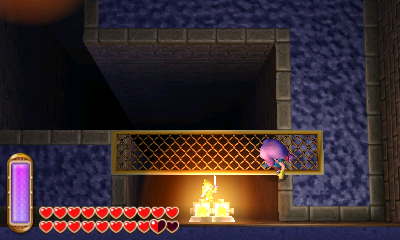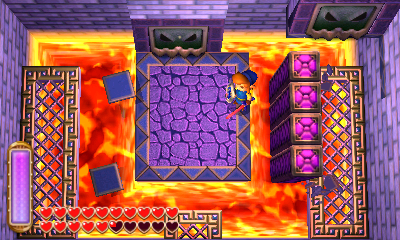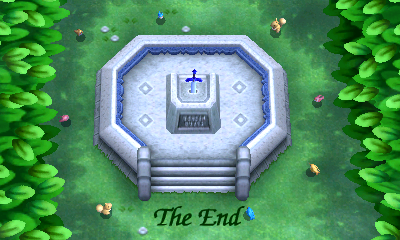I think this is one of the best Zelda games. And yes, I still put it into Tier Three. Also, major plot spoilers ahead for several Zelda games. Proceed with caution.
A Link Between Worlds is the first Zelda game I’ve completed (partly because it’s one of only three that have interested me and partly because I needed to justify my recent purchase of a 3DS). Admittedly, that may have soured me on it more than normal, and if I had stopped sooner I might have put it into Tier Two. I only hope I can accurately explain my reasoning. But at least I get to write a great sentence now:
Ritual and Myth
The downfall of The Legend of Zelda as a franchise is its slavish devotion to ritual, rather than an exploration of myth and legend. You see, The Legend of Zelda is a franchise about exploration, myth, and legend – but almost every game is the same tired formula: collect the Triforce, rescue the Seven Sages (or Six or Nine or Four*), defeat Ganondorf, and a discover that a character or two who are not what they seem.
* Admittedly they’re not called sages, but they fill the same story role.
I suppose it may seem too fine a point to distinguish between myth and ritual, but I think I can compare The Legend of Zelda to a better franchise to explain what I mean. In Dark Souls, the myth is the same each time: the chosen undead is to kindle the first flame to prolong the age of fire or to usher forth the age of dark. I mean, probably. Who really knows, you know? Heh. Heh. Heh. Heh.
Anyway, the point is that in Dark Souls – especially in III – the myth has endured and you are simply the fulfillment of that myth. How it happens and what happens along the way is entirely different. The one who linked the flame might be the god Gwyn, someone who just wants to rule the world, or an amalgamation of all those who linked the flame before. Contrast this with The Legend of Zelda: Ganon is the final boss. He is always (minus one) the final boss, even if it has to be shoehorned in. He’s always named Ganon (or Ganondorf), for some reason. He is always unilaterally evil (this point by itself isn’t necessarily a bad thing). It’s boring.
Both of these games contain a cycle – an unavoidable destiny. But where you’ll fight the same enemies and bosses in The Legend of Zelda over and over again, the people who populate the world of Dark Souls change, fading and re-emerging as the cycle repeats. They’re all undead, but they’re different undead. The story is different, but the same. It’s a myth, not a ritual.
There are, of course, exceptions in the Zelda Canon (HERE BE SPOILERS). In Wind Waker, Zelda is Tetra. In Ocarina of Time, she’s Sheik (I just wish she’d only been Sheik). The finale of Majora’s Mask is inside a moon crashing into Termina and Ganon is nowhere to be found. The Sages are absent from Breath of the Wild. The point is that there are departures from the formula – just not enough and not within the same game. If they were less frustrating mechanically, I might consider one of the two biggest departures from the formula – Majora’s Mask or Breath of the Wild – to be the best Zelda game, and Breath of the Wild probably gets that title anyway.
Mechanics
Ah, where to begin. Well, first off, Egoraptor is right about a lot of things, and rewatching his video after beating the game resonated with my feelings a great deal. I’d been interested in testing his complaints since watching a rebuttal some time ago. I have attempted to play Ocarina of Time on several occasions (including recently on my 3DS), but the little annoyances everywhere were enough to stop me each time. While many of these are better in A Link Between Worlds, they aren’t fixed entirely.
Transitions and cutscenes are still too frequent and take just a tad too long. I didn’t think this would bother me, especially since it is significantly faster than Ocarina of Time, but the few seconds the game would pause whenever accomplishing something or opening a chest gradually wore down my patience. I just want to push the button. You don’t need to pause the game, play a sound effect, pan six feet to the left, show a door open, and pan back every time. In fact, it would be more interesting if I didn’t know what pushing the button did without paying attention. That would be, you know, a puzzle that required exploration.
While A Link Between Worlds is a return to mostly 2.5D mechanically, it is a game released for the 3DS so there are still many frustrating times the game breaks its 2D-ness. Several enemies (bats and wizards in particular) are often floating just out of reach – even with the 3D mode on, it can be difficult to tell if you can swing your sword to hit them – a disadvantage the enemies most certainly do not share.
In general, the combat is awful. There’s no penalty for continuously swinging your sword, and almost every enemy in the game from octoroks to lynels will die without issue if you back either you or them into a corner and just keep swinging. The ones that can defend can defend indefinitely, meaning you can swing your sword forever and accomplish nothing. I encountered two enemies in the game which required me to use my shield – otherwise, the right trigger is practically useless (to the point that I can’t actually remember if it was the right or left trigger). I gained new appreciation for Dark Souls’ stamina bar and parry abilities. I was confused why Breath of the Wild didn’t use stamina for combat and A Link Between Worlds made me beg for it.
The boss fights are uninteresting, if for no other reason than they’re the same boss fights from other Zelda games and generally just involve doing the same thing over and over again. Worse still, the majority of the final boss fight against Ganon is a quick time event. Swing your sword to reflect a ball of energy back and forth. Merge into the wall and fire an arrow. Swing your sword a couple times to start the process over again.
There’s even a section where I couldn’t figure out what to do and Ganon just sat there quietly while I tried a bunch of things. The answer reminded me of the Portal 2 moonshot, except instead of feeling brilliant and realizing a bunch of clues across the game fit together, I just turned around. The game still acted as if it was a brilliant idea, though.
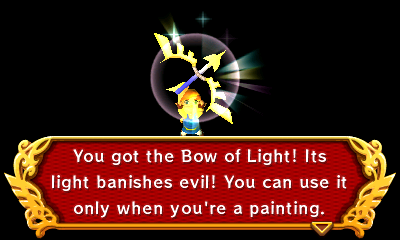
For the most part, there’s very little challenge involved in A Link Between Worlds. I’ve beaten the game, but I don’t feel any more accomplished, skill-wise, than I did at the start. Dying is usually a consequence of not having purchased a healing potion and making a few too many mistakes or not farming hearts wherever you go. A few puzzles were momentarily confusing, but there was nothing I had to give my full attention to. If there’s a switch, hit it. If there’s a blocked passage, bomb it. If you can merge into the wall, do it.
Saving my most frustrating complaint for last is the aiming mechanism. Despite having a control stick, a 3D character model, and a sword that can aim in every direction, Link can only aim items in 8 directions. Many of the items are touchy about this (especially on the 3DS’ stick), and getting shots lined up is often remarkably frustrating because of it.
It’s not all bad, of course. The reason I was interested in this game was the new mechanic – the ability to merge into walls and become a 2D sprite in a 3D world. It’s an incredibly unusual idea, and a fantastic new mechanic to include. There are plenty of opportunities to use this ability and the entire world is designed with your ability to merge into walls in mind. Secrets, dungeons, everything. Suspiciously so, in fact.
Exploration
This brings us to the downside of the new mechanic. It breaks the narrative of the game. Many of the dungeons and puzzles you travel through require the use of this ability, which was an unknown power in Hyrule before the inciting incident. These people in the puzzle rooms: how did they expect to get the treasure? How did they even get in the dungeons in some cases, when the only way I got there was with my fancy ability? Clearly, the people designing these places must have known about this ability, since only I was able to solve it.
Contrast this to a competent puzzle game, Portal 2. The test chambers you are forced through by GLaDOS have a reason for existing and are designed around the player having a Portal gun for a reason. As you make your way through the crumbling facility outside the test chambers, it’s as if you’re forging your own path that no one else could have because of your special ability. Introducing such an unusual and inventive mechanic requires you to think through the consequences of its existence. In A Link Between Worlds, it never feels like you’re “breaking the rules” by using your ability. Instead, calling back to Egoraptor, it’s like you’re at a theme park.
Just like a theme park, the dungeons are like the big name rides (how’s that for a transition sentence?). Some of them are fine. Some of them are ice levels with enemies specifically designed to knock you off the thin platforms while you slide around with limited control. I never thought Blighttown would seem safe in comparison. Thinking back to Dark Souls, while I recall several instances where walking along thin beams came up, these instances were either short, not terribly dangerous, or were just bad execution of a good idea. A Link Between Worlds does not have any excuses, other than “It’s an ice level. We have to have an ice level.”
That actually seems to be a recurring theme with Zelda – encounters exist only because they’re supposed to, not because it would be interesting (similar to my issues with theming). For example, there are a couple occasions where you enter an area and panels on the floor rise up and fly towards you. Once they finish, an elevator or button or something is revealed. Why is this here? Certainly not because it is fun or challenging, but probably because they did it in A Link to the Past.
While I have a lot of complaints about the exploration in A Link Between Worlds, it is at least better than Ocarina of Time. I think this comes down to having an item seller rather than discovering items in dungeons – practically from the start, you’re able to rent/purchase all the items you need for a reasonable price and open up the entire world map. Items are therefore useful in multiple dungeons and across the world, rather than being used in just one dungeon and then never again (well, except for the sand rod).
I think it would have been better if each dungeon required that you upgrade one of your items to beat it – that way, you can still have puzzles that require the use of multiple items to beat while still keeping a sense of progression. Of course, this would also require that the upgrade system not be based on the most generic fetch quest template possible.
As a side note, the fetch quest (to find 100 maiamai children) is again a problem with implementing a mechanic without thinking through the consequences on the world: How did these children get spread across multiple worlds? Why are they embedded in cliffs, hidden under rocks, or covered by pavement? These questions aren’t answered, which breaks the immersion in the world of Hyrule/Lorule.
Hopefully, I can finally make the argument I’ve been building towards: The Legend of Zelda: A Link Between Worlds has no purpose. It’s not combat, since the combat is neither deep nor challenging. It’s not puzzles, since the puzzles are practically nonexistent or entirely optional. It’s not exploration, since your map is just marked with all the places you have to go and the dungeons are all just differently themed same-ness. It’s certainly not story, since 90% of it is the same story as every other Zelda and the remaining 10% are reveals which can be seen a mile away (the identity of the item seller, Ravio, was a surprise, but has absolutely 0 consequence to the story).
Despite this, I did have some fun with the game. Too much of it was a slog for it to escape Tier Three, but the few fun elements that were there almost brought it up to Tier Two. That being said, immediately after beating this game I booted up the original Dark Souls to relax. I hadn’t opened it for at least a year, but even when I found myself in Sen’s Forge (very confused and clipped into a wall, no less) and died to some horribly weak enemies over and over again for half an hour, I still had more fun than I was having by the end of A Link Between Worlds. Maybe I’ll go find the DLC now, and apparently play through the mod I installed. I never did find the Ash Lake.
